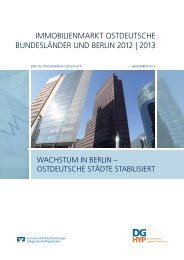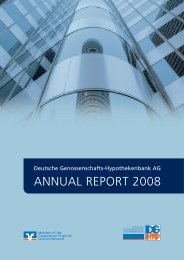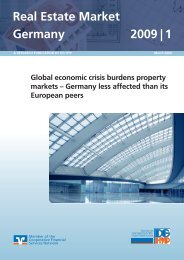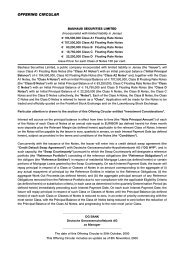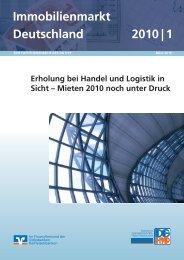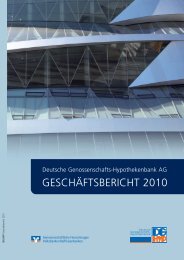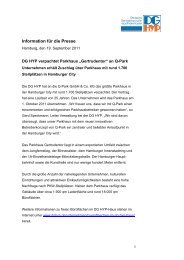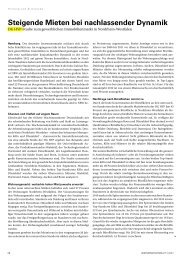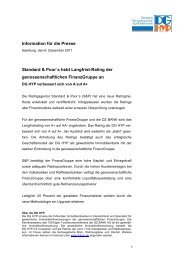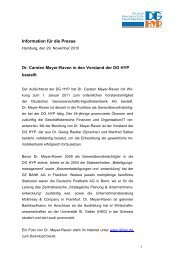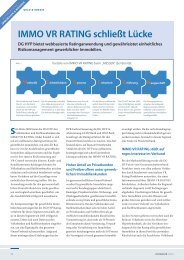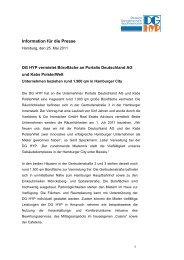Covered Bonds - DG Hyp
Covered Bonds - DG Hyp
Covered Bonds - DG Hyp
You also want an ePaper? Increase the reach of your titles
YUMPU automatically turns print PDFs into web optimized ePapers that Google loves.
<strong>DG</strong> HYP COVERED BONDS – PFANDBRIEFE – QUALITY THE PATH OUT OF THE CRISIS SPECIAL MAY 2009<br />
Naturally, we should stress at this point that a double-A rating is also still a very good grade<br />
that continues to imply minimal probability of default. Sovereign Spanish and Irish bonds for<br />
instance no longer carry best-of-breed ratings from all three agencies.<br />
The rating downgrades are likely to impact on the spreads of the pfandbriefe concerned<br />
however, once we know for certain which issues are going to be affected. The loss of the<br />
best-possible rating, should the investor’s house rules make AAA ratings mandatory, could<br />
even force investors to divest their holdings of the issues concerned and further intensify the<br />
pressure on the spreads.<br />
Investor sentiment<br />
The main problem that the covered bond market as a whole and pfandbriefe specifically see<br />
themselves facing at the moment, is the extreme negativity of investor sentiment. Although<br />
the pfandbrief market was the last covered bonds segment to hit the skids, the damage it<br />
has suffered appears to be relatively severe. The biggest difficulty in rebuilding trust in<br />
German paper is the lack of empirical experience. In the past (before the crisis), investors‘<br />
attitude towards pfandbriefe was clear: a quality product that can look back on an over twohundred-year<br />
history with not a single default or case of arrears, and which got a further<br />
massive boost with the introduction of the jumbo segment in 1995, is like Caesar’s wife –<br />
beyond criticism. As a result, demand mostly ran far ahead of supply, and swap spreads<br />
knew only one direction – down and down.<br />
This perception of the market has not only changed, it has swung to the opposite. The<br />
financial world‘s problems are being projected 1:1 onto the pfandbrief market, and<br />
Germany‘s version of covered bonds is taking such a caning that the protective<br />
mechanisms built into the programs are now being completely overlooked.<br />
To counter this change, the other market participants now need to focus on responding to<br />
investors‘ demands – to the extent that investors and their wishes can be channelled at all.<br />
To allow the investor community an opportunity to speak with one voice, the <strong>Covered</strong> Bond<br />
Investor Council (CIBC) was established just a few weeks ago to enable investors to<br />
express anonymous criticism of the market structure. This council is intended to provide the<br />
necessary counterweight to the bodies that already represent the interests of issuers and<br />
dealers (market makers). We all have to remember that at the end of the day, it is investors<br />
who drive the market and breathe life into trading in the first place.<br />
Over the recent months, we have observed a clear shift in investors‘ expectations of what<br />
needs to change in the covered bonds market to make them even consider investing again.<br />
Whereas at the beginning of the crisis it was deficient liquidity they complained about,<br />
investors are now more critical of the market’s lack of transparency, especially on the part of<br />
issuers. Their accusation is that the information available to the market and therefore to<br />
investors is not sufficient to enable them to get a full picture of the risks inherent in specific<br />
covered bonds or pfandbriefe.<br />
Demand for more transparency<br />
But what should this enhanced transparency actually deliver? In general, most investors’<br />
first instinct will presumably be to get their hands on all the information they possibly can.<br />
This includes detailed cover-pool data on for instance the origin and nature of cover assets<br />
and their LTVs, plus data on maturity transformation in the pool. They also want to know the<br />
ins and outs of the insolvency regime – including naturally a focus on the statutory basis.<br />
Spread widening very probable<br />
Positive attitude of investors<br />
towards pfandbriefe...<br />
..has swung to the opposite<br />
Investor Council – the voice of<br />
investors<br />
Transparency and liquidity called for<br />
As much information as possible<br />
11




